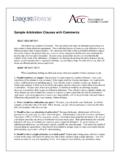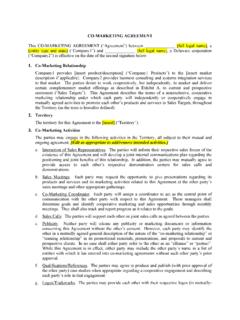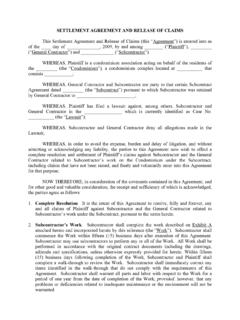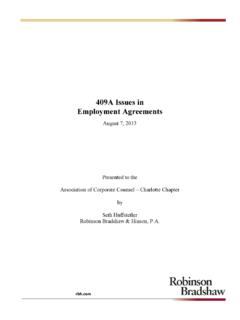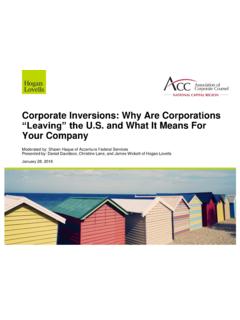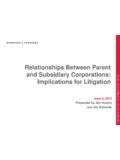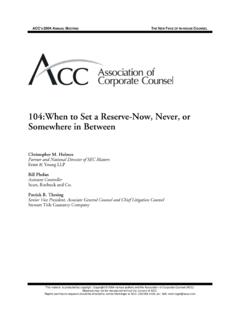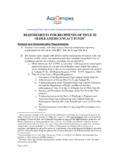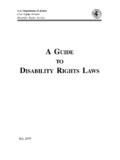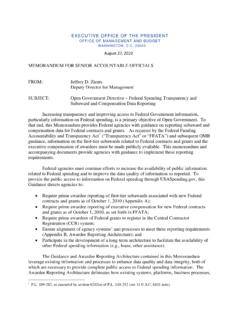Transcription of Training Nonlegal Revised 9.15.10 Clean - acc.com
1 !!!!!"#$%&'()*! Training Non-Legal Employees Sponsored by: Training Non-Legal Employees!Copyright 2010 WeComply, Inc. & Association of Corporate Counsel!2 ! Training Non-Legal Employees Updated September 2010 Provided by the Association of Corporate Counsel 1025 Connecticut Avenue NW, Suite 200 Washington, DC 20036 USA tel +1 fax +1 Providing law-related Training for non-legal clients ( , for managers and, to a lesser degree, non-managerial personnel) is an important function of every in-house legal department. This is especially vital in the area of corporate compliance, where Training on pertinent laws and regulations can help prevent and detect legal problems and limit or mitigate the organization s exposure if violations occur. Beyond compliance issues, in-house counsel may also find it useful to train non-legal personnel on how to perform certain quasi-legal functions that might otherwise consume a busy legal department s scarce resources.
2 For example, with the appropriate Training and tools, non-legal managers may be able to lead contract negotiations and drafting, or investigate employee complaints (with attorneys providing advice and oversight as needed). This cross-functionality frees up attorneys from what can be time-consuming tasks and enhances the value of the non-attorney managers job functions. This InfoPAKSM will discuss the practical and logistical challenges of planning and executing these Training initiatives. The information in this InfoPAK should not be construed as legal advice or legal opinion on specific facts, and should not be considered representative of the views of WeComply or ACC or any of its lawyers, unless so stated. This InfoPAK is not intended as a definitive statement on the subject, but rather to serve as a resource providing practical information for the reader. This material was compiled by WeComply, Inc., an ACC Alliance Partner. For more information about WeComply, see the About the Author Section of this document (p.)
3 26) or visit !For more ACC InfoPAKs, please visit !3 Contents I. Compliance A. Why Bother: Legal and Business 1. It s the Law The Legal Case for 2. It s Good for the Organization The Business Case for B. Developing a Training 1. Designing a Compliance 2. Developing the Training 3. Deciding on a Delivery 4. Selecting Trainer(s) and/or Vendor(s)..18 C. Implementing the 1. Instructor-Led 2. 3. Blended 4. Following II. Other Law-Related Training A. Contract B. Responding to III. About the IV. Additional V. Training Non-Legal Employees!Copyright 2010 WeComply, Inc. & Association of Corporate Counsel!4 I. Compliance Training No organization needs or wants legal problems. At a minimum, they re distracting to management and employees, harmful to the organization s reputation, and costly to deal with even if the organization has done nothing wrong. Legal problems can lead to litigation, judgments, significant fines or even prison terms for individuals, debarment from government contracting, huge drops in market capitalization, and, as we ve seen all too often in the last decade, an organization s total demise.
4 Some of these problems originate at the highest levels of an organization, where those in control presumably understand their legal constraints but nevertheless choose to act unethically or unlawfully. Arguably, no amount of ethics and compliance Training can change these individuals behavior. However, many legal problems originate at lower levels, where employees may act improperly out of ignorance, misunderstanding, or a devil-may-care disrespect of the laws, regulations , rules, and policies governing their day-to-day job responsibilities. Many of these problems can be mitigated or completely avoided through employee Training . The following sections are intended to help you (i) understand the legal and business drivers for employee Training as part of your organization s compliance program; (ii) develop Training content that effectively conveys essential compliance information to employees; (iii) deliver that information in an engaging, convenient, and efficient manner; (iv) follow up to ensure that all employees who need Training actually receive it; and (v) track all of these activities so that you can easily prove each employee s Training participation if needed.
5 While it may initially seem that your organization can t afford the time and cost of a comprehensive Training plan, there are resources and technologies available to make the process easier and less expensive than you might think. Indeed, you may conclude that your organization can t afford not to institute a robust Training plan. A. Why Bother: Legal and Business Drivers Until the late 1990s, compliance Training was only a priority in heavily regulated industries, such as healthcare and securities, and on issues considered high-risk because of past compliance failures, such as antitrust and foreign bribery. But organizations today, in every industry, face a constantly thickening regulatory scheme covering an increasingly broad range of issues. Organizations whose employees don t know, understand, and follow all applicable laws and regulations can no longer expect to fly under the radar and escape all scrutiny. 1. It s the Law The Legal Case for Training In addition to a plethora of industry-specific laws and regulations , a growing number of federal, state, and local laws impose compliance requirements on organizations in almost all industries and of almost all sizes.
6 Consider how many of the following laws apply to some or all parts of your organization: !For more ACC InfoPAKs, please visit !5 a. Federal Laws/ regulations i. In the Workplace ! Discrimination and Harassment: title VII of the Civil Rights Act of 1964 (covering discrimination on the basis of race, color, sex, religion, or national origin), the Pregnancy Discrimination Act, and the Americans with Disabilities Act (ADA) apply to organizations with 15 or more employees. ! Age Discrimination: The Age Discrimination in Employment Act (ADEA) applies to organizations with 20 or more employees. ! Wage/Hour Issues: The Fair Labor Standards Act (FLSA) and the Equal Pay Act apply to organizations with an annual volume of business of $500,000 or more. ! Employee Leave: The Family and Medical Leave Act (FMLA) applies to organizations with 50 or more employees during at least 20 workweeks per year. ! Immigration: The Immigration and Nationality Act (INA) applies to organizations of all sizes.
7 Ii. Data Privacy and Security ! Personal Health Information: The Health Insurance Portability and Accountability Act (HIPAA) applies to organizations of all sizes whose activities involve the use or disclosure of personal health information. ! Financial Information: The Gramm-Leach-Bliley Act (GLBA) applies to organizations of all sizes that provide any type of banking, lending, securities, insurance, or trust services to consumers. ! Consumer Information: The Fair and Accurate Credit Transactions Act (FACTA) applies to organizations of all sizes that maintain or service personal accounts with a foreseeable risk of identity theft. ! Personal Information Received from the EU: The Commerce Department s Safe Harbor program applies to organizations of all sizes that receive personal information from the European Union, Switzerland, and Canada. iii. Health and Safety ! Employee Injuries and Illnesses: The Occupational Safety and Health Administration (OSHA) requires most organizations with more than 10 employees to keep injury and illness records, and requires organizations of all sizes to report any workplace incident resulting in a fatality or the hospitalization of three or more employees.
8 ! Environmental Health: Most environmental health laws and regulations ( , CERCLA and RCRA) apply to organizations of all sizes. Training Non-Legal Employees!Copyright 2010 WeComply, Inc. & Association of Corporate Counsel!6 iv. General Business ! Code of Conduct and Ethics: The Sarbanes-Oxley Act requires publicly traded companies to have a code of conduct and ethics and ensure that all employees understand their responsibilities under the code. ! Fair Competition: antitrust laws and their EU and Canadian counterparts (so-called competition laws ) apply to organizations of all sizes. ! Anti-Corruption: The Foreign Corrupt Practices Act (FCPA) applies to organizations of all sizes. ! Anti-Money Laundering: The USA PATRIOT Act requires all financial institutions (defined broadly by the Act) to train employees to recognize and prevent money laundering. ! Securities Trading: Federal laws prohibiting insider trading and selective disclosure of material, nonpublic information apply to organizations of all sizes.
9 ! Foreign Trade: The Office of Foreign Assets Control (OFAC) sanctions programs and trade embargoes apply to organizations of all sizes. ! Imports/Exports: customs and export-control laws and regulations apply to organizations of all sizes. b. State and Local Laws/ regulations Every state and many counties, cities, and other localities have laws and regulations on many of the above topics (and others) applying to organizations of all sizes. 2. It s Good for the Organization The Business Case for Training a. It Helps Prevent and Detect Improper Conduct The primary objectives of a compliance program are to prevent and detect misconduct and ensure that an organization conducts its activities in compliance with all applicable laws, regulations , and rules. For any such program to be successful, employees must know and understand these legal requirements and know how to respond appropriately when problems arise. While most employees have a common-sense understanding of what types of workplace conduct are obviously improper, many legal and policy requirements are not obvious or may run counter to some employees social or cultural norms.
10 Nowhere is this more true than in the realm of workplace discrimination and harassment, where the essentially zero-tolerance approach of federal, state, and local laws is difficult for many employees to grasp and follow. Likewise, there are subtleties in laws related to data privacy, information security, anticompetitive conduct, insider trading, record management, acceptable Internet usage, and similar workplace issues that require much more than just a common-sense understanding. By developing a Training plan that helps employees understand the laws and policies that apply to them, an organization demonstrates its commitment to furthering the primary objectives of its compliance program. Active enforcement of that Training plan could well determine how or whether law-enforcement authorities pursue a claim of wrongdoing against the organization and/or its officers and !For more ACC InfoPAKs, please visit !7 b. Good Ethics Is Good Business Research indicates that a solid commitment to ethics and compliance has economic and other payoffs, as well.
